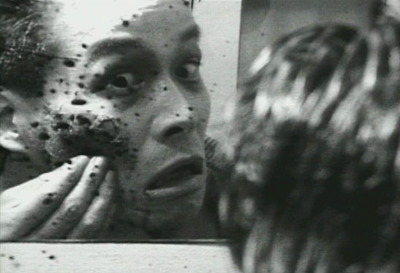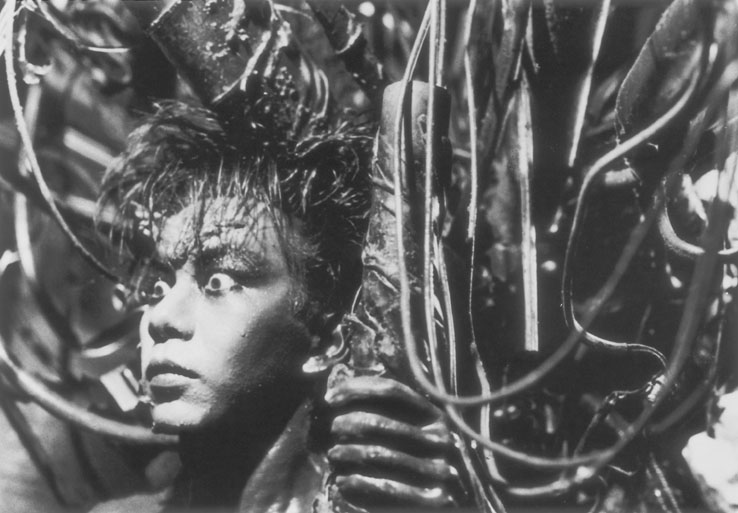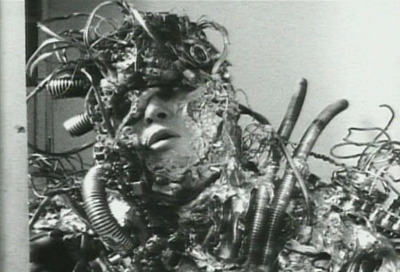Tetsuo: The Iron Man (鉄男: Tetsuo) is a 1989 Japanese cyberpunk film by cult-film director Shinya Tsukamoto produced by Japan Home Video. This, his third film, is an extremely graphic but also strikingly-filmed fantasy shot in the same low-budget, underground-production style as his first two films. Tetsuo established Tsukamoto internationally and created his worldwide cult following. It was followed by Tetsuo II: Body Hammer (1992) and Tetsuo: The Bullet Man (2009).
http://en.wikipedia.org/wiki/Tetsuo:_The_Iron_Man
A strange man known only as the "metal fetishist", who seems to have an insane compulsion to stick scrap metal into his body, is hit and possibly killed by a Japanese "salaryman", out for a drive with his girlfriend. The salaryman then notices that he is being slowly overtaken by some kind of disease that is turning his body into scrap metal, and that his nemesis is not in fact dead but is somehow masterminding and guiding his rage and frustration-fueled transformation.
http://www.imdb.com/title/tt0096251/plotsummary
At the end of the 80s, when mainstream Japanese cinema was dead in the water and the decade's one original filmmaker, Sogo Ishii, was going through a creative crisis, along came a grainy, black & white 16 mm film that wiped the floor with anything made in Japan for several years.
Shinya Tsukamoto's Tetsuo was a relentlessly energetic film made at a time when the energy had all but disappeared from Japanese film. The culmination of a decade's worth of short filmmaking and the crowning achievement on the activities of a private, experimental theatre group, Tetsuo had all the characteristics of unbridled zeal and amateur enthusiasm, and all the signs of true filmmaking talent.
The design of the iron man combines elements from the work of artist H.R. Giger, the aforementioned Jan Svankmayer as well as Japan's own kaiju films. The comparison to Godzilla and co is not just a visual one. The theme of mutation which lies at the heart of the big monster movies (particularly Ishiro Honda's first Godzilla / Gojira, 1954) is replayed here. But in Tetsuo, the damage is done on a much smaller scale: that of the individual. In that sense, Tsukamoto has much in common with David Cronenberg, an influence which is often mentioned. The two filmmakers share not only the fascination with the vulnerability and mutability of the flesh, but also find common sources for these mutations in sex.
http://www.midnighteye.com/reviews/tetsuoim.shtml
Almost 25 years after it first exploded in the face of moviegoers, Shinya Tsukamoto’s cyberpunk mindfuck, ‘Tetsuo: The Iron Man’ still continues to attract new fans unto its jittery cult. Tsukamoto is undoubtedly one of the most idiosyncratic filmmakers out there, even in the already gonzo world of Japanese cyberpunk cinema. ‘Tetsuo: The Iron Man’ is a film that is experienced more than passively watched. It is forged of scrap metal salvaged from a junkyard future where life is the marriage of man and machine, sex and death. In another sense, it is also a visceral, feature length industrial music video. And for this, we have Chu Ishikawa to thank.
Ishikawa’s score for ‘Tetsuo: The Iron Man’ is a stunning example of late-80s Industrial music and a perfect fit for Tsukamoto’s twisted imagery. It pummels, scrapes, screeches and tears through the speakers. Often beginning as abstract soundscapes that flirt with Japanese noise music, rhythmic clatter inevitably rises out of the sonic detritus. The animalistic beats, themselves made of metal, drive the point home, intensifying the horror of the film.
http://mondoexploito.com/?p=2221
Tetsuo was Shinya Tsukamoto's ticket to world-wide
cult fame. The movie is canonized as a part of Japanese movies 101 in
the west and countless pages has been written about it, even though the
movie is impossible to explain.
Tetsuo is the best cyberpunk movie ever made.
It is also beautiful.
http://www.kurutta.com/2009/08/tetsuo.html






No comments:
Post a Comment